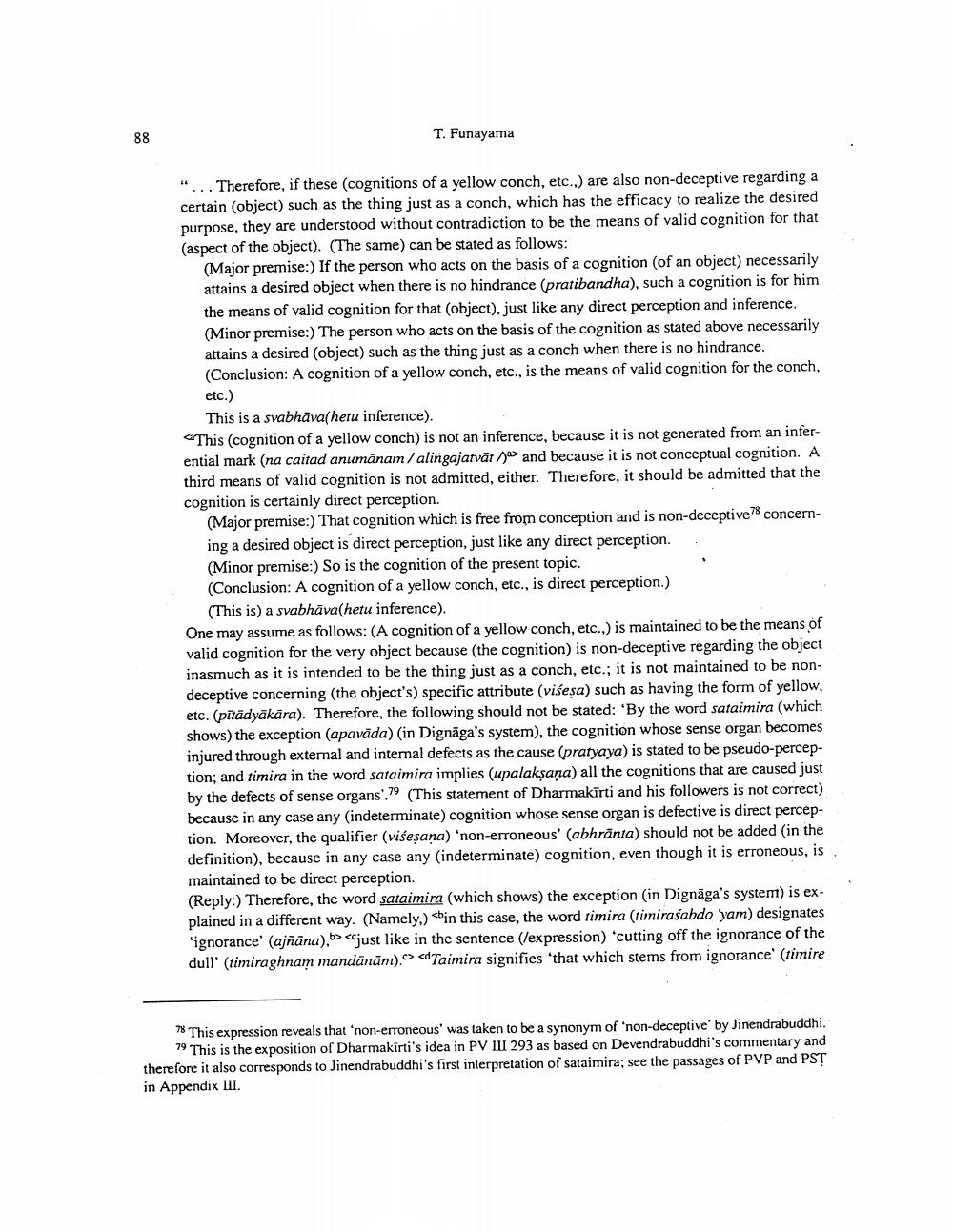________________
T. Funayama
"... Therefore, if these (cognitions of a yellow conch, etc.,) are also non-deceptive regarding a certain (object) such as the thing just as a conch, which has the efficacy to realize the desired purpose, they are understood without contradiction to be the means of valid cognition for that (aspect of the object). (The same) can be stated as follows:
(Major premise:) If the person who acts on the basis of a cognition (of an object) necessarily attains a desired object when there is no hindrance (pratibandha), such a cognition is for him the means of valid cognition for that (object), just like any direct perception and inference. (Minor premise:) The person who acts on the basis of the cognition as stated above necessarily attains a desired (object) such as the thing just as a conch when there is no hindrance. (Conclusion: A cognition of a yellow conch, etc., is the means of valid cognition for the conch, etc.)
This is a svabhāva(hetu inference). This (cognition of a yellow conch) is not an inference, because it is not generated from an inferential mark (na caitad anumānam/alingajatvāt / and because it is not conceptual cognition. A third means of valid cognition is not admitted, either. Therefore, it should be admitted that the cognition is certainly direct perception.
(Major premise:) That cognition which is free from conception and is non-deceptive concerning a desired object is direct perception, just like any direct perception. (Minor premise:) So is the cognition of the present topic. (Conclusion: A cognition of a yellow conch, etc., is direct perception.)
(This is) a svabhāva(hetu inference). One may assume as follows: (A cognition of a yellow conch, etc.) is maintained to be the means of valid cognition for the very object because (the cognition) is non-deceptive regarding the object inasmuch as it is intended to be the thing just as a conch, etc.; it is not maintained to be nondeceptive concerning (the object's) specific attribute (visesa) such as having the form of yellow, etc. (pitādyākāra). Therefore, the following should not be stated: “By the word sataimira (which shows) the exception (apavāda) (in Dignāga's system), the cognition whose sense organ becomes injured through external and internal defects as the cause (pratyaya) is stated to be pseudo-perception; and timira in the word sataimira implies (upalaksana) all the cognitions that are caused just by the defects of sense organs.79 (This statement of Dharmakīrti and his followers is not correct) because in any case any indeterminate) cognition whose sense organ is defective is direct perception. Moreover, the qualifier (visesana) 'non-erroneous' (abhrānta) should not be added in the definition), because in any case any indeterminate) cognition, even though it is erroneous, is maintained to be direct perception. (Reply:) Therefore, the word sataimira (which shows) the exception (in Dignäga's system) is explained in a different way. (Namely,) <hin this case, the word timira (timiraśabdo yam) designates 'ignorance' (ajñāna),b> <just like in the sentence (/expression) cutting off the ignorance of the dull' (timiraghnam mandānāni).> <dTaimira signifies that which stems from ignorance' (timire
78 This expression reveals that 'non-erroneous' was taken to be a synonym of 'non-deceptive' by Jinendrabuddhi.
79 This is the exposition of Dharmakirti's idea in PV III 293 as based on Devendrabuddhi's commentary and therefore it also corresponds to Jinendrabuddhi's first interpretation of sataimira; see the passages of PVP and PST in Appendix III.




